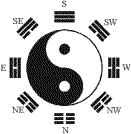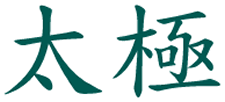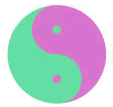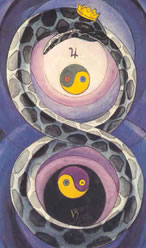
Cloud Hands - Yun Shou
January 28, 2004
Bibliography Graphics Links Notes Quotations
(Note: This webpage will be completed by September, 2004.)

Explanation and Notes
"The Way gave birth to unity,
Unity gave birth to duality,
Duality gave birth to trinity,
Trinity gave birth to the myriad creatures.
The ten thousand things carry yin and embrace yang.
They achieve harmony by combining these forces."
- Tao Te Ching, Lao Tzu, # 42, c 500 BC
Translations by Victor Mair, Gia-Fu Feng, and Jane English
Return to the Top of This Page
![]()

Bibliography and Links
Chinese Philosophy and Tai Chi Chuan - Chinese Cosmology. By Dan Docherty. 21Kb.
Dao House: Of Discourses and
Dreams "A compendium of
links to
great online Daoist (Taoist) resources." An excellent selection of
fine
links with informative and fair annotations; all presented in an attractive
and easy to read format. The in-depth and creative collection of links are
arranged by 18 topics.
Diagram of
the Supreme Ultimate 39Kb. Chou Tun-yi (1017-1073)
prepared a Diagram
of the Supreme Ultimate, and an Explanation of the Diagram of the
Supreme Ultimate.
The Dao of Yin and Yang
in Taijiquan By Dr. John Painter. 15Kb
Mathematics and
Informatics in Old Symbols: Tai Chi Symbol and Hexagrams
from the I Ching. By Klaus-D. Graf.


The
Shambhala Guide to Taoism. By Eva Wong. Boston,
Shambhala, 1997. Index,
appendices, 268 pages. ISBN: 1570621691.
Silk Reeling Energy - The Soul of T'ai Chi. By Zhang Fuxing. Tai
Chi, Vol. 24,
No. 6, December, 2000, pp. 42-45.
T'ai
Chi According to the I Ching: Emobodying the Principles of the Book of
Changes.
By Stuart Alve Oson. Inner Traditions, 2000. 240 pages.
ISBN: 0892819448.
Taiji Diagram and
Yang Style. By Mei Ying Sheng. Translated by Ted W.
Knecht. 18Kb.
Tai Chi Symbol.
By Vincent Chu. 20Kb.
T'ai Chi Symbol and Sword Postures. By Xiao J. Li. Tai Chi,
Vol. 24, No. 5, October 2000, pp. 33-37. An excellent informative article.
The
Tai Ji Symbol and the Oviphile Swastika. By Ming Zhen
Shakya.
Useful instructions for drawing the Tai Chi symbol. 34Kb.
Tai Chi Tu
(Supreme Ulitmate Symbol)
Taoism and the
Philosophy of Tai Chi Chuan. An excellent content rich website!
By Christopher Majka and Empty
Mirrors Press.
Taoism: The Way of the Mystic. By J. C. Cooper. New York,
Samuel Weiser, Inc.,
1972. 128 pages. ISBN: 0877281726.
Thank you to the following persons for sending me useful information and
good ideas: Gary Brewer.
Traditional Chinese
Diagnosis Five Elements Chart. 23Kb.
Two Versions of a Chinese
Cosmological Diagram 5Kb NeoConfucian
Diagram
Vitality,
Energy, Spirit: A Taoist Sourcebook. Translated and edited
by Thomas Cleary. Boston,
Shambhala, 1991. 281 pages. ISBN: 0877735190.
Which Way Up Should the
T'ai Chi Go? By Mark Shackelford.
Wu-Chi to
Tai-Chi 12Kb
Return to the Top of This Page

Quotations
"The term "Tai Chi" first appeared in the "Book of
Change" better known as "I Ching", in
which it is said "Out
of Tai Chi is born two elements; out of two elements are born the four
phenomenas; out of the four phenomenas are form the eight trigrams." The
term Tai Chi
here refers to the originator of everything. Later in the Northern
Song Dynasty, a
neo-Confucian philosopher by the name of Chow Ton Yee expanded
this notion with the
contribution from Taoism. He used the Tai Chi symbol to
demonstrated the common elements
in everything. What he did was make a circle to represent Wu Chi stage. Inside this Wu Chi
circle, he drew a wave line in the
middle separating two equal black and white components
to represent yin and
yang. The black component represented yin and the white component
represented
yang. Inside the white component was a black dot to show that yin existed in
yang
and inside the black component was a white dot to show that yang existed in
yin. With this he
established a duality principle to explain that yin and yang
are the most basic of all things.
When these two components intercourse,
everything mutlipied. Later, when this duality principle
became popular, people
used the term "Tai Chi" as Tai Chi symbol to represent the universe.
Now, we can see that the term "Tai Chi" in the Book of Change does not
have the same meaning
as
the term "Tai Chi" in the "Tai
Chi"symbol. The first one refers to the originator of all things
and the
second one refers to the duality principle."
- Gin Soon
Tai Chi Chuan Federation

"In the picture above, the white area represents ch'i, or heaven; the
dark area is the
image, or earth; the dividing line is the Law, or principle. In the quote
from the I Ching,
"sage" referes to Fu Hsi who created the eight trigrams, the t'ai chi
symbol. The
above symbol is a curved prepresentation of the sages's Yellow River Map and the
Lo
River Writing. It was molded into cyclic fashion from its originally
linear representation
because the the straight line is blocked at both extremes. This circling
enables
the peak of yin to produce yand and vice versa. The two principles of yin
and yang
never separate from each other, but rather each follows the other - smoothly and
endlessly. There are no other world factors than the ch'i, law, and
image. Neither
man nor the myraid creatures deviate from these three principles."
- Cheng Man-ch'ing, Cheng
Man-ch'ing: Master of Five Excellences, 1995, p. 158.
"In time the common people of China and the Daoists adopted this second
version of the
symbol for taiji, which also was said to have been created by master Chou Tun-I.
It is the
“double fish diagram” and is often mistakenly called the yin and yang. This
icon is actually
called taiji tu or grand ultimate terminus principle. The black and white
curved circles fitting
into each other express the Dao of eternal wholeness. The unbroken line
surrounding the
two symbolizes wuji. The reversed “S”-shaped curved line in the center
simply divides the
two. The two dots mean that nothing is ever absolutely one thing. Each thing
contains just
a little of the essence of the other. Taiji tu also represents continuous
interaction or movement.
The meaning of the taiji symbol’s white and black hemispheres evolved over
time. They
became symbolic of everything physical, spiritual and emotional in the
universe—male
(yang), female (yin); sun (yang), moon (yin). For everything up there is a down.
For every
back there is a front. There is no separate yin without yang or yang
without yin. The two are
part of one whole—the taiji—and the taiji is the creative principle of Dao.
You can apply
this idea to almost any situation and gain a deeper understanding of nature at
work."
- John Painter, The
Dao of Yin and Yang in Taijiquan
"Tai Chi is commonly translated as "Supreme Ultimate" (hence
we get the prideful
and totally non-Taoist "Supreme Ultimate Boxing." A better
translation is
"Great Polarity," as in yin-yang, male-female, positive-negative, the
abiding
principle of the universe. "Chaun" is literally
"fist," or "system of self-defense."
So: Tai Chi Chuan is the system of self-defense based upon the principle of the
great polarity."
- Wolfe Lowenthal, There are No Secrets, p. 72

Change: Two of Disks
Aleister Crowley, Thoth Tarot Deck,1969
Ordo Templi Orientis
Painted by Lady Frieda Harris
U.S. Games Systems, Inc.
Return to the Top of This Page
![]()
Graphic Arts
Garden Snake Colorado Herpetological Society Logo
Revolving Tai Chi graphics created by Michael P. Garofalo,
for his Cloud Hands
website and for his Concrete
Poetry Show IV:
![]()
![]()
![]()
Tai Chi Symbol
Instructions for making an origami Tai Chi symbol . 20K, PDF.
Yinfishy
By Carl Attenisese Jr. Image
Return to the Top of This Page
![]()
Red Bluff, Tehama
County, North Sacramento Valley, Northern California, U.S.A.
Close to the Cities of Chico, Orland, Corning, Los
Molinos, Cottonwood, Anderson, and Redding CA
Valley Spirit Taijiquan Journal
© Michael P. Garofalo, 2004, All Rights Reserved
Cuttings: Haiku and Short Poems
Cloud Hands: Tai Chi Chuan and Chi Kung Website
Tai Chi Chuan, Taijiquan, T'ai Chi Ch'uan,
Tai Chi, Tai Ji Quan, Taiji, Tai Ji Chuan, Tie Jee Chewan
Chi Kung, Qi Gong, Qigong, Chee Gung, Qi, Chi, Tu Na, Dao Yin, Yi, Neigong,
GongFu
Research Notes
The explicit concept of Wu Chi (other than it's appearance in the Tao Te Ching) appeared on a Taoist diagram ("Diagram of the Ultimateness - Wu Chi T'u") in the early 10th century A.D., which is credited to the Taoist priest Ch'en T'uan. The concept of T'ai Chi did not originate until the 11th century, where the neo-Confucist Chou Tun-yi (1017-1073) created a diagram that changed the name of Wu Chi to T'ai Chi as well as changing the interpretation ("Diagram of the Supreme Ultimate - The T'ai Chi T'u"). (see:
Some contend that the concept of "Tai Chi" can be traced back to
Fu-hsi (2852-2738 B.C.), the first recorded
Chinese
ruler.
Quote from I Ching
Tai Chi may have been a later concept as the first known reference to Tai Chi in Chinese literature is in Appendix III of the Book of Changes (I Ching) which dates from around the 2nd century BC It states:-
"The I (Book of Changes) has Tai Chi (the Great Ultimate),
It gives birth to the Two Forms (i.e. Yin and Yang).
The Two Forms give birth to the Four Emblems;
The Four Emblems give birth to the Eight Trigrams."
Quote for Tao Te Ching
"Lu Tung-pin transmitted his teachings to several students who in turn became founders of their own schools of the arts of longevity. One of them was Chen Hsi-yi, who was most famous for his innovative techniques of ch'i-kung. Chen Hsi-yi's form of internal alchemy integrated the cosmology of the I-ching, the Confucian ideas of cultivating virtue, and physical techniques of circulating energy. Sung dynasty (960-1279 CE)
In the internal alchemy of Chang
Po-tuan, lead and mercury are the essence for yin and yang energies in the body,
the furnace is the heat generated in the lower tant'ien, the cauldron is where
the internal energy is refinded, pumping the bellows refers to regulating the
breath and controlling the heat of the lower tan-t'ien, the immortal fetus is
the bundle of refined energy that is the seed of longevity and immortality, and
the tenmonth incubation of the fetus in the womb refers to the length of time
required for the internal pill to mature."
Chang Po-tuan (987-1082 CE)
Traditions of Inner Alchemy. By Eric Wynants. 65KB.